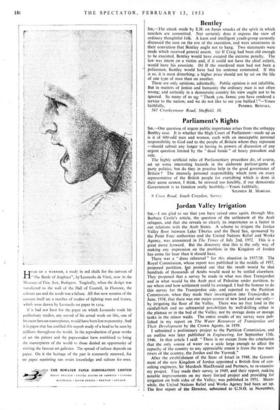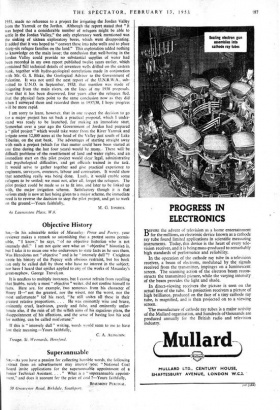Jordan Valley Irrigation
Sut,-1 am glad to see that you have raised once again, through Mrs. Barbara Castle's article, the question of the settlement of the Arab refugees, and that she reveals so clearly its importance as a factor in our relations with the Arab States. A scheme to irrigate the Jordan Valley floor between Lake Tiberias and the Dead Sea, sponsored by the Point Four authorities and the United Nations Relief and Works Agency, was announced in The Times of July 2nd, 1952. This is a great move forward. But the discovery that this is the only way of making any impression on the problem in the Kingdom of Jordan has come far later than it should have.
There was a " dress rehearsal" for this situation in 1937/38. The Royal Commission, whose report was published in the middle of 1937, proposed partition, tut pointed out that the result- would be that hundreds of thousands of Arabs would need to be settled elsewhere. They proposed that a survey be made in what was then Transjordan and in what would be the Arab part of Palestine under partition, to see where and how settlement could be arranged. I had the honour to do this survey for the Transjordan side, and reported to the Partition Commission, when they made their investigation into Transjordan in June, 1938, that there was one major source of new land and one only— by irrigating the floor of the Valley. There was no free land in the rainfall-belt and no substantial possibilities by well-drilling either in the plateau or in the bed of the Valley, nor by storage dams or storage tanks in the minor wadis. -The entire results of my survey were pub- lished in my report on The Water Resources of Transjordan and Their Development by the Crown Agents, in 1939. I submitted a preliminary project to the Partition Commission, and an outline was later published in Engineering, for September 13th, 1946. In that article I said: "There is no escape from the cdnclusion that the only source of water on a scale large enough to affect the capacity of the country to any appreciable extent is from the trio main rivers of the country, the Jordan and the Yarmuk."
After the establishment of the State of Israel in 1948, the Govern- ment of the new Kingdom of Jordan appointed a British firm of con- sulting engineers, Sir Murdoch MacDonald and Partners, to re-examine my project. They made their survey in 1949, and their report, making notable improvements on my more limited project and providing for irrigation on both sides of the Valley; was published in 1951. Mean- while, the United Nations Relief and Works Agency had been set up. The first report of the Director, submitted to -UNA). in November, 1951, made no reference to a project for irrigating the Jordan Valley from the Yarmuk or the Jordan. Although the report stated that "it was hoped that a considerable number of refugees might be able to settle in the Jordan Valley," the only exploratory work mentioned was the sinking of sixteen exploratory bores, which were disappointing. It added that it was hoped to " convert these into tube wells and to place thirty-six refugee families on the land." This exploration added nothing to knowledge on the main issue; the conclusion that well-boring in the Jordan Valley could provide no substantial supplies of water had been recordeAin my own report published twelve years earlier, which contained-full technical details of seventeen wells drilled on the eastern hank, together with hydro-geological correlations made in conjunction with Mr. G. S. Blake, the Geological Adviser to the Government of Palestine. It was not until the next report of the U.N.R.W.A., sub- mitted to U.N.O. in September, 1952; that mention was made of irrigating from the main rivers, on the lines of my 1938 proposals. Now that it has been disCovered, four years after the refugees fled, that the physical facts point to the same conclusion now as they did when I surveyed them and recorded them in 1937/38, I hope progress will be more rapid.
I am sorry to learn, however, that in one respect the decision to go for a major project has set back a practical propoSal, which I under- stand was ready to be launched, for making an immediate start. Somewhat over a year ago . the Government of Jordan had prepared a "pilot project" which would take water from the River Yarmuk and irrigate some 12,000 acres at the head of the Valley just south of Lake Tiberias, on the east bank. The advantages of starting straight away with such a project (which for that matter could-have been started at any time during the. last four years) would be many., There will: be difficult problems- of the resettlement of-land and water rights. and an immediate start on this pilot project would clear legal, administrative and psychological difficulties, and get officials. trained in the task. It would serve to gather together and give practical experience to engineers, surveyors, overseers, labour and contractors. It would show that something really was being done. Lastly. it would enable some refugees to be settled; we must not, after all, forget the refugees. The pilot project could be made so as to fit into, and later to be linked up with, the major irrigation scheme. Satisfactory though it is that serious study is now at last being given to a major scheme, the immediate need is to reverse the decision to stop the pilot project, and get to work on the ground.—Yours faithfully,



































 Previous page
Previous page